Keyboard Percussion
Grip for 2 Mallets
1. The Fulcrum
- The fulcrum is located between the thumb and middle finger/forefinger
- Wrap the fingers around the mallet starting from the little finger and working forward
- The main contact points on the mallet are the thumb, forefinger and little finger.
- The forefinger should be 'out' and relaxed, not curled under the mallet
2. Hand and Mallet Positioning
- Keep the hands flat and parallel to the ground
- Position hands approximately two inches above the plane of the keyboard (a perspective too high or too low will result in a diminished sound quality and potential injury).
- Mallet heads should be together and in the Up Position
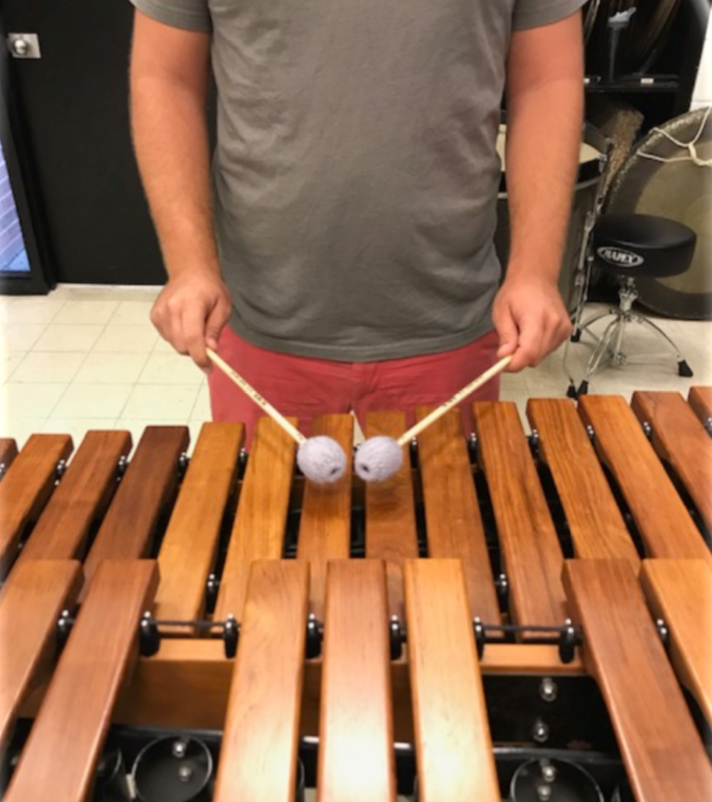
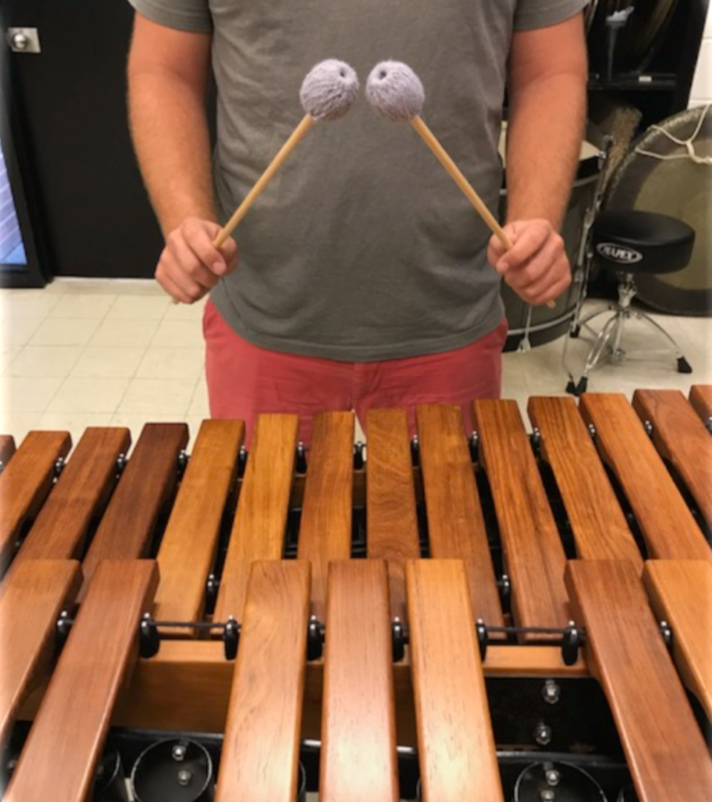
3. Stance and Body Positioning
- Feet should be at least shoulder width apart (the distance between the feet will vary from player to player because of height differences).
- Weight should be distributed evenly with the knees slightly bent and relaxed.
- The relationship of the body to the instrument should allow the mallets to comfortably strike the center of the 'natural' keys.
- Move laterally up and down the keyboard, keeping the mallets in the center of the body. Position your body, when possible, centered to the range of the musical passage you are playing.
- Do not bend forward at the waist.
Sound Production
Piston Stroke
- Play in the center of the bar on natural notes, and the front edge of the bar on accidentals. Do not 'stack' the mallets. This will result in a loss of tone.
- The location of the 'set point' (of the mallet heads) will be relative to the dynamic that is being played (if playing softly, the set point will be much lower than playing loud).
- Keyboards produce very little rebound, therefore the piston stroke is the key to fluid motion.
Grip Pressure
- To increase articulation, apply pressure between the thumb and forefinger.
- This increase (or decrease) in pressure should not affect the wrist motion.
Stroke Breakdown and Guidelines
- Play from the wrist
- The wrist should have a knocking motion, with the wrist hinging at the base of the forearm.
- Avoid 'lifting' the arm/forearm. The wrist initiates the stroke, with the motion of the stroke being felt through the head of the mallet.
- Path of Mallet
- The mallet head should travel in a straight path into and away from the instrument.
- Adhere to Dynamic Levels
- Length of stroke should be consistent right to left hand.
- Do not overplay attacks of releases.
- Dynamics are achieved through adjusting the length of the stroke. Striking surface harder or softer will alter the style of the stroke, resulting in a change of articulation. Consistency in tone quality is dependent on maintaining the style of the stroke within the given dynamic.
Playing Zones
A playing zone is the area where the mallets hits the bar. The keyboard is made of 'natural' notes, of the lower board and the 'accidentals' (flats and sharps) or the upper board. For the naturals, the optimum area for striking the bar is in the center. For the accidentals, the same is true, but in order to facilitate playing the instrument, striking the bar on the bottom edge produces a nearly equal quality tone. Striking accidentals on the bottom of the bar requires less arm motion when playing the instrument.
Avoid playing over the string at all costs. These areas are known as "nodes" or "nodal point" and produce an undesirable, non-resonant sound.
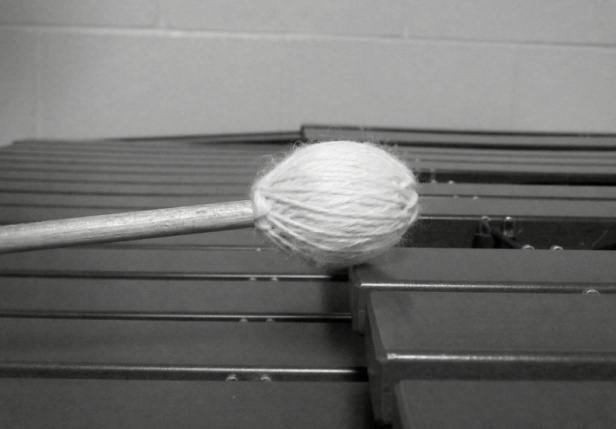
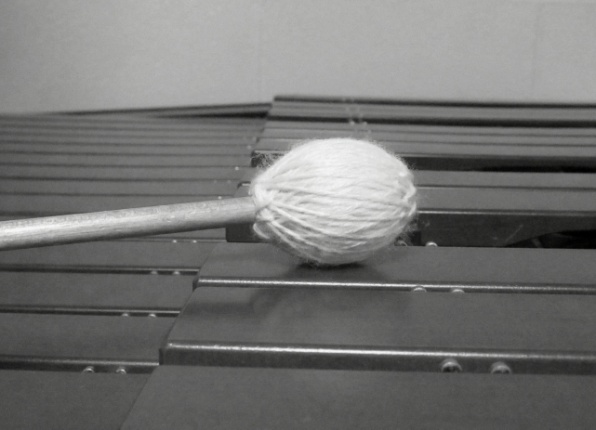
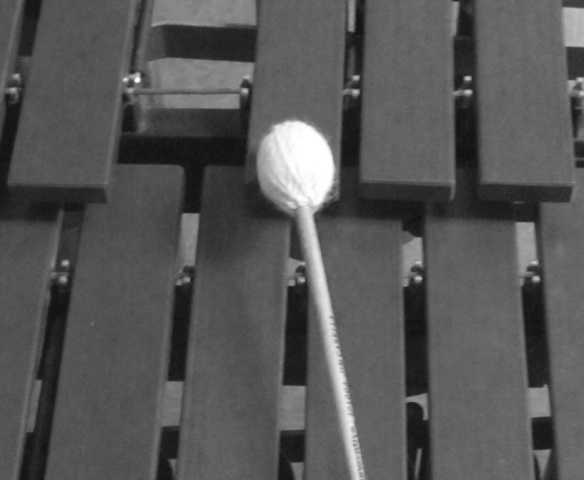
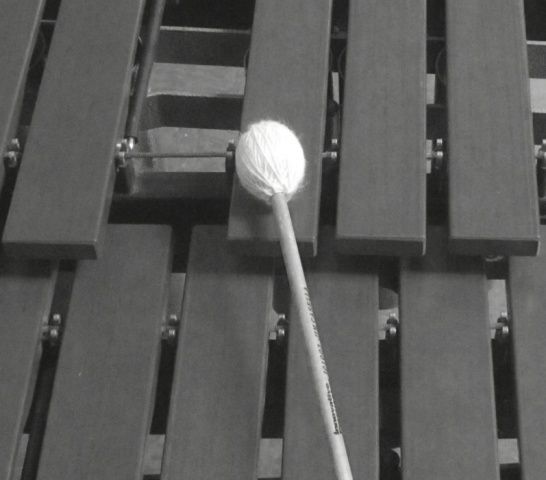
Sticking
Natural sticking (right hand or left hand lead) is not normally practical on keyboard instruments because of the horizontal arrangement of the notes. Sticking for certain passages relies heavily on the sticking most naturally allowing for “open’ hand positioning, especially at the end of a phrase or transitioning into another phrase. In general, you can apply the following as a guide (nothing below is hard-and-fast, however):
Try to end a phrase in an “open” position, meaning that your hands are not crossed on the last two notes. Work backwards in the phrase to determine which hand you should begin on and if any double sticking is required.
- If the musical passage is mostly ascending, use a right-hand lead
- If the musical passage as descending, use a left hand lead
- Double stick only on repeated notes if necessary. Avoid double sticking on note changes, unless the interval is small
- Change hands on changing notes
- Keep large interval leaps in an open handed position.
Stacking and Mallet Direction
By using the Piston Stroke and having your mallets in the Up position, crossing mallets is usually easily avoidable. However, it can sometimes feel like our mallets “get in the way” of the other mallet. While it’s ideal to play in the center of the naturals bars, it’s also necessary to play off center sometimes. The clearest example would be when executing a single stroke roll on any bar. For accidentals, you would position one mallet on the edge of the bar and the other mallet on the middle area of the bar, across the string. For naturals, you would need to offset both mallets and play in the middle “area” of the bar. It is not necessary to hit the same exact spot with both mallets when playing a roll or rhythmic pass on the same bar.
Knowing this, it’s sometimes necessary to offset one mallet to allow for the other mallet to travel to another note more easily, in a direct line. Slightly off-setting a mallet backwards towards the body will often clear the way for the other mallet to move more freely.
Also, when playing a musical passage, care should be taken to determine which mallet should be on “top” and which mallet should be on “bottom” so as not to create a “barrier” when either mallet must cross the path of the other mallet.
Grip for 4 Mallets
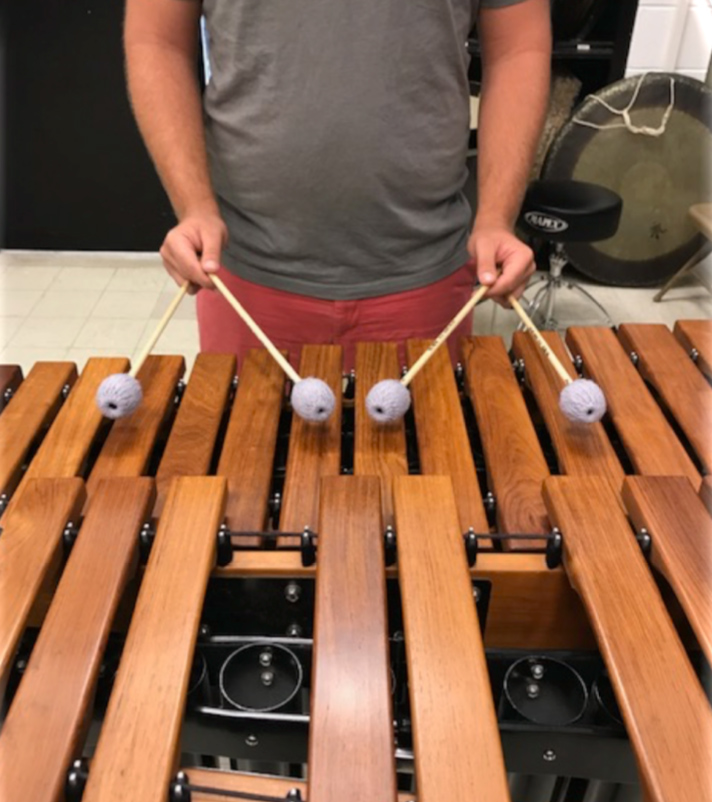
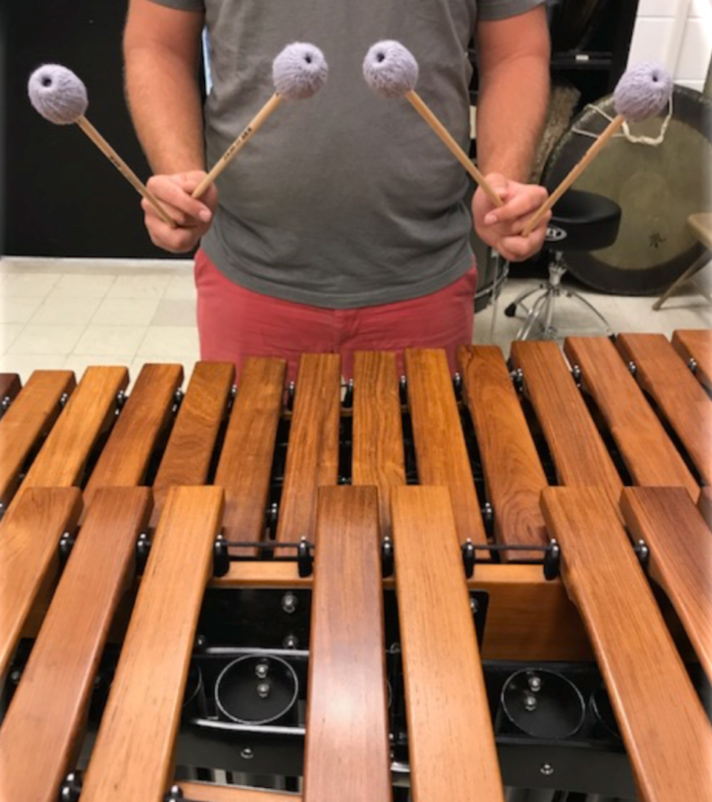
Outside Mallets - 1 and 4
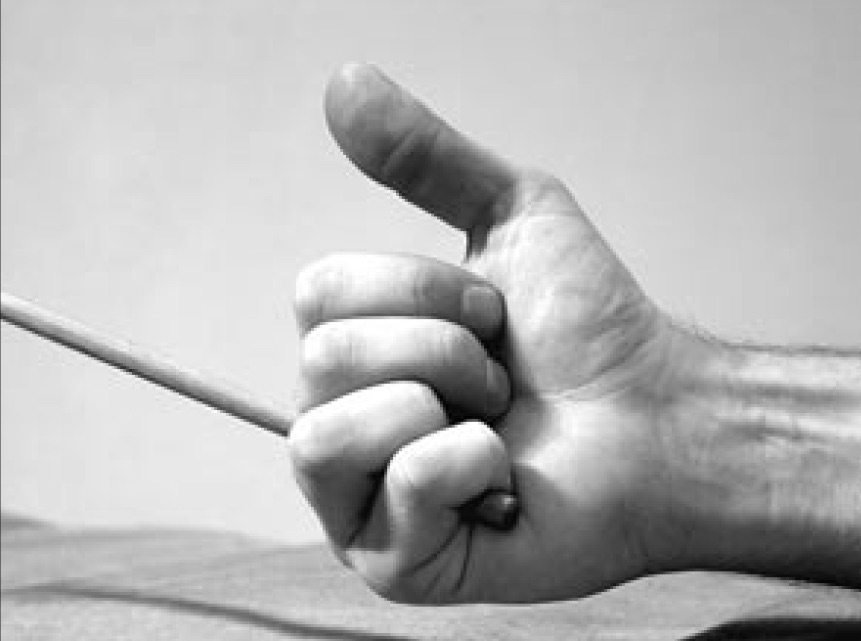
Start with the arm hanging at the side - wrist and fingers relaxed. Raise the forearm from the elbow until it is parallel to the floor. Turn the wrist so that the surface of the thumbnail is parallel to the ceiling.
Slip the shaft of a mallet between fingers 2 and 3. Rest it on the second joint of the third finger.
Now curl fingers 3 and 4 around the shaft until the tips of the fingers just touch the section of the palm near the base of the fingers. Adjust the length of the mallet so that only 1/8th of an inch protrudes beyond the third section of the fourth finger. The shaft of the mallet should touch the second finger in its first section, closer to the second joint than the first.
Check the following points before proceeding:
- Fingers should be relaxed - mallet hangs in position
- Weight of mallet heads should pull up slightly on ends of fingers 3 and 4; more so on 4.
- Shaft should lie on top of the second joint of the third finger and beneath the first section of the second finger, close to, but not beneath the second joint.
- Edge of the hand should face the floor.
Inside Mallets - 2 and 3
Place the end of the mallet handle lightly into the palm flesh 1 to 1 1/2 inches beneath the base of the thumb. Set the shaft down on the side of the third joint of the first finger. The weight of the mallet will be distributed like a hanging lever: the end of the handle will pull up on the flesh beneath the thumb, and the shaft will push down on the first finger. The mallet should be balanced in position.
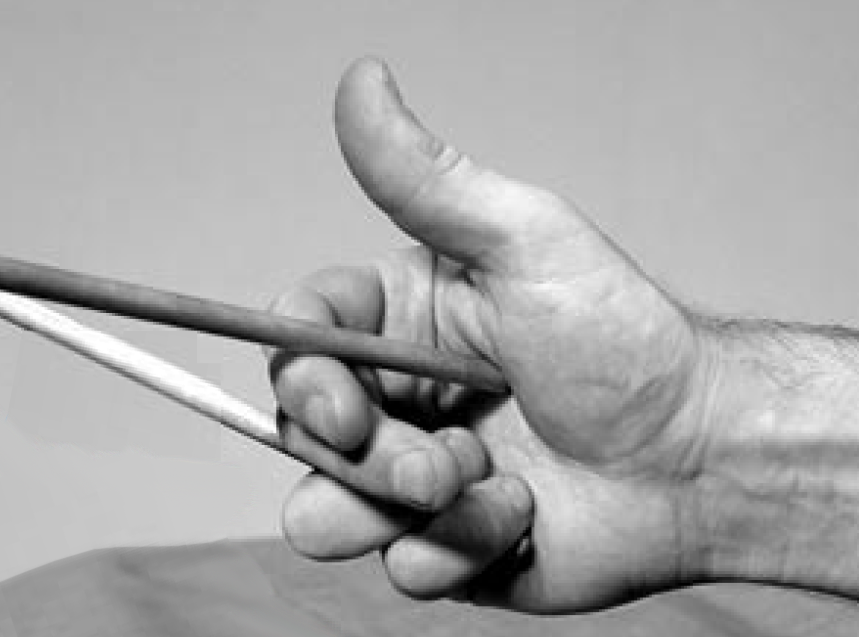
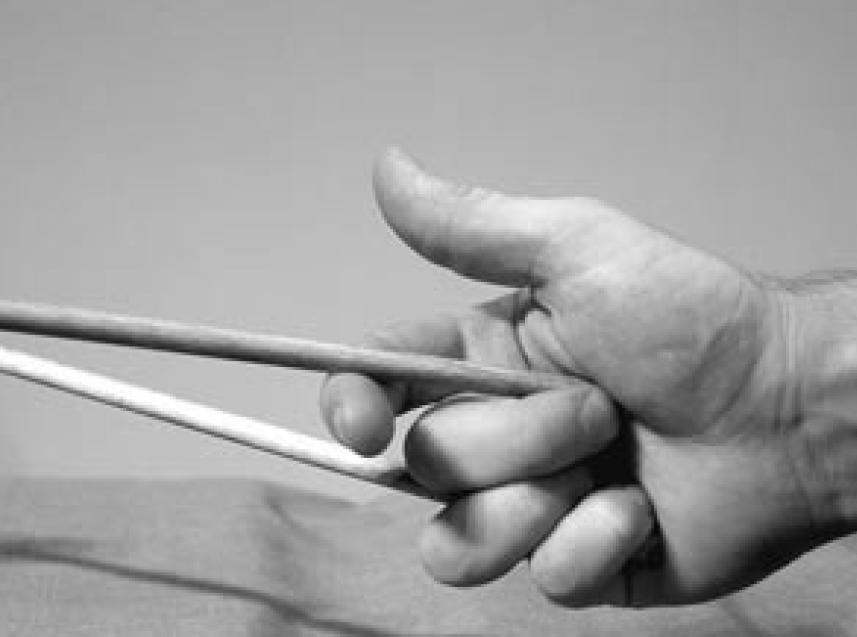
Check the following points before proceeding
Fingers and wrist should be relaxed.
- Position of fingers holding the outside mallet should not have changed.
- Inside mallet should hang between the flesh in the base of the thumb and the third joint of the first finger.
- Drop thumb onto handle. Curl joints of the second finger so that the third section of the second finger touches the end of the shaft.
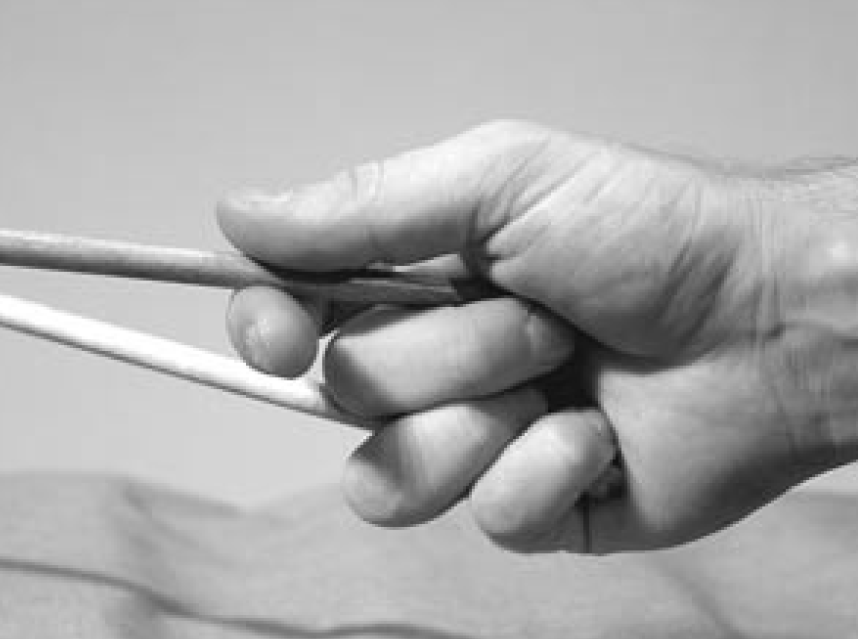
Stroke Breakdown and Guidelines
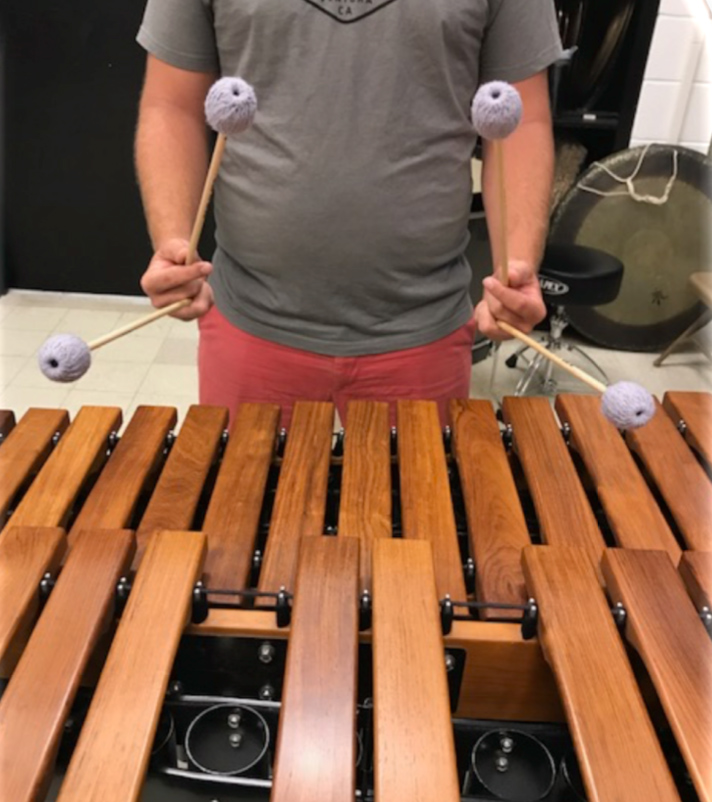 Double Verticals - This stroke is initiated from the wrist and will include some residual arm motion at any height above 9”. The stroke should happen quickly while staying relaxed. The “wrist pop” is when the top of the wrist moves upwards slightly as the mallets hit the instrument. This should be visible at slower tempos and will become more fluid as the tempo increases.
Double Verticals - This stroke is initiated from the wrist and will include some residual arm motion at any height above 9”. The stroke should happen quickly while staying relaxed. The “wrist pop” is when the top of the wrist moves upwards slightly as the mallets hit the instrument. This should be visible at slower tempos and will become more fluid as the tempo increases.
Permutations and Single Alternating Strokes - When one mallet hits the instrument at a time, it is important that all other mallets stay in the “up position.” The up position should feel like the top of a double vertical stroke, but only one mallet comes down at a time.
Inner Mallets - When playing with only the inner mallets, the outer mallets will stay in the down position. The inner mallets will achieve the desired height by turning your wrists so that the bottoms of your hands turn in towards each other.
Double Lateral Rolls - The double lateral roll sticking we use is 4312. The stroke begins with a vertical descent from the up position for the first note, followed by a rotation towards the other mallet. This results in one swift, efficient and fluid motion creating two notes.
Independent Roll - This technique happens when one hand rolls on one or more notes at the same time. This is achieved with a rapid toggling motion between the two mallets. The two mallets can be visualized as a quick and continuous seesaw motion for this technique.
Mallet Choices
Choosing the right mallet to use for a particular piece of music is a skill all its own. One look through a percussion catalog and one soon realizes that there are an enormous variety of mallet types for all keyboard instruments. Every mallet produces a slightly different sound on any keyboard instrument, from very soft to very loud and with a very percussive attack to almost no attack at all.
To begin to understand how to choose a mallet, one must first understand how mallets are made. Mallets have essentially three basic parts: the shaft or handle, the core and the wrap.
Shaft
Mallet shafts are predominately made of rattan, birch wood or some sort of synthetic material such as fiberglass. Rattan handles are very flexible and are preferred by many players because the shock of striking the keyboard is absorbed somewhat in the shaft, thereby lessening the shock to the player's hands. Several drawbacks to using rattan shafts are that the length of the mallet is generally a bit shorter than birch and the rattan has a tendency to warp, resulting in a slightly curved shaft.
Birch shafts are very light weight but remain straight and resist warping. They tend to be longer than rattan handles and therefore a slightly larger interval range with playing with four mallets. Many players feel a greater sense of control and accuracy when using birch handles.
Shafts made with synthetic materials typically are of lesser quality although there are some instances of sufficient quality depending on use.
Core
The core of the mallet is hidden from view since it is wrapped with yarn, but the core is probably the greatest variable when it comes to producing different sounds. Cores are made from a variety of materials from very hard to very soft rubber and a variety of synthetic plastics of various densities. Cores can also be wrapped with another layer of material such as rubber, felt or moleskin.
Some mallets are unwrapped. Unwrapped mallets are generally for xylophone and bells, but can also be used on marimba and (sometimes) vibraphone. Unwrapped mallets generally produce a more percussive attack, although this is still dependent on the density of the material. A soft rubber mallet may still be softer and less percussive than a wrapped mallet.
Wrap
Most mallets for marimba and xylophone are wrapped with yarn or twine. Mallets can be wrapped tightly or loosely with soft or hard yarn or twine. All of these factors affect the sound of the mallet. Incidentally, different manufacturers choose different colors of wraps to identify the different styles of mallets they produce. This scheme varies greatly from manufacturer to manufacturer so comparing "blue" mallets from different manufacturers is not a way to determine if they are comparable.
In order to choose the right mallet, it is usually necessary to experiment with different mallet types until you find the one that works best with the musical selection. Because there are so many variables that affect mallet sound, a huge variety of sounds can be produced on a single instrument. The same principle applies to almost every percussion instrument. This is one of the things that make playing percussion instruments so exciting!
